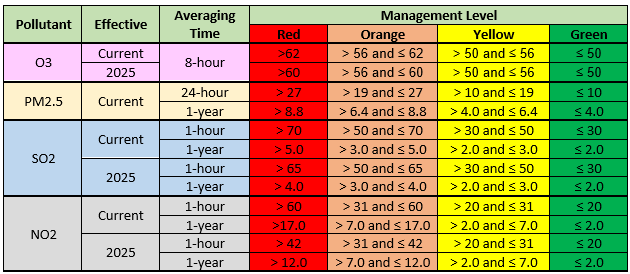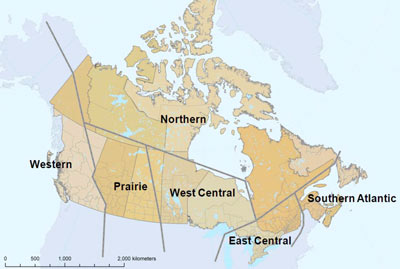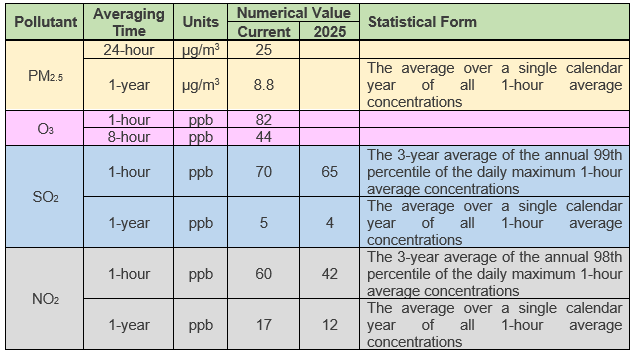The Air Quality Management System (AQMS) is a new approach for protecting and improving air quality in Canada. Built on intergovernmental collaboration and stakeholder engagement, its objective is to achieve continuous improvement of the air quality in Canada with emphasis on transparency and accountability to the public.
The maintenance and improvement of outdoor ambient air quality drive the system. This is achieved by employing five main mechanisms:
- Canadian Ambient Air Quality Standards (CAAQS);
- Base Level Industrial Emission Requirements (BLIERs);
- Management of local air quality through the Management of Local Air Zones;
- Management of regional air quality through the Management of Regional Airsheds; and
- Collaboration to reduce Mobile Source Emissions.
The System builds on what governments across Canada have been doing for many decades and provides a framework to develop consistency among laws, policies and practices with collaboratively developed Canadian standards and requirements. The System provides a framework that is both strong and flexible so Canadian governments may effectively respond to many different air quality challenges across the country.
The System will be transparent and accountable to Canadians, so that everyone may understand both the quality of the air that they are breathing and the actions that are being taken to improve it and keep it clean.
Canadian Ambient Air Quality Standards
Achievement of the Canadian Ambient Air Quality Standards (CAAQS) is the underlying basis of the Air Quality Management System (AQMS). The CAAQS are health and environment based numerical values of outdoor air concentrations of pollutants whose purpose is to drive continuous improvement in air quality. They are designed to provide a uniform measure of protection for human health and the environment across the country by establishing new ambient air quality standards for fine particulate matter (PM2.5), ozone (O3), sulphur dioxide (SO2), and nitrogen dioxide (NO2). All levels of government will be expected to work together to achieve the CAAQS.
The province has adopted the CAAQS for SO2 and NO2 under the Air Pollution Control Regulations, 2022. The CAAQS for PM2.5 and O3 have not been adopted by the province as they are not as stringent as the current legislation.
https://assembly.nl.ca/Legislation/sr/regulations/rc220011.htm
The CAAQS are:

The provincial standards are:
Air Zone Management
Air zones are provincially defined finite areas located within a specific airshed, that exhibit similar air quality issues and challenges throughout and whose purpose is to facilitate effective management of air quality at a local scale. Within each air zone, emissions are managed in such a way that air pollutant concentrations and associated health risks are minimized. Air zones do not cross provincial/territorial boundaries; they are contained within a single province or territory.
By definition, if local air quality issues are addressed at the locations of maximum concentration, then all local air quality issues within an air zone will be addressed. Air quality issues in an air zone arising from long-range transport and/or transboundary pollution would be addressed at the airshed level. For AQMS purposes, the province is divided into two air zones.
- Newfoundland Air Zone: Island of Newfoundland (including all associated islands)
- Labrador Air Zone: Labrador (including all associated islands)
The level of air quality management in each air zone will be dependent upon the degree to which the air quality compares to the CAAQS. Annually, the province reports on the emissions and air quality within each air zone including actions taken to reduced air pollution and maintain the air quality.
The Air Zone Management Framework consists of four separate air pollution concentration ranges, called Management Levels. Each management level is colour-coded, and associated with a suite of air management, monitoring and reporting actions that become progressively more rigorous as air quality approaches the CAAQS. The Management Levels are:

Under the Framework, each colour-coded Management Level is separated by a different Threshold Value. A Threshold Value is a specific air pollution concentration that marks the start of a new Management Level. Each of the CAAQS metrics has a different set of Threshold Values, but each is set based on the same approach. The threshold values are:

Air Zone Management Reports
The air zone management reports can be found on the Publications page, under Science Annual Reports.
Airshed Management
Regional airsheds are broad geographic areas that encompass a number of air zones and cross either provincial/territorial or international boundaries. They reflect broad regions across the country that experience similar air quality characteristics and behaviour such as terrain influences, type/quantity of industrial emissions and air mass movement patterns.
The function of regional airshed management is to:
- help better understand the flow of air pollution across provincial/territorial and national borders;
- ensure coordination of air quality management where needed to address concerns about the transport of air pollution across airsheds (inter-provincial, inter-territorial and international);
- serve as the basis for reporting on the outcomes of the Air Quality Management System (AQMS) and trends in air quality across the constituent air zones within National State of the Air reports; and
- facilitate the discussions with the United States on air pollution moving across the national boundary.
Six airsheds have been identified across the country. Newfoundland and Labrador is split between two of the six, with the island of Newfoundland being part of the Southern Atlantic airshed and Labrador being part of the Northern airshed.

Base Level Industrial Emission Requirements
The Base Level Industrial Emission Requirements (BLIERs) are quantifiable requirements placed on industrial operations that are reflected in regulations or permits, and are applicable to new or existing facilities/units/equipment and include equipment standards, process standards, facility standards, fuel-based standards or a combination thereof. Qualitative requirements would be applied where it is not feasible to implement a numerical emission limit.
The stringency of BLIERs matches what leading jurisdictions – inside or outside Canada – require for comparable industrial sources in attainment areas (areas where air quality standards are being met without the highly stringent requirements designed to address severe air quality issues), adjusted where necessary for Canadian circumstances. A BLIER should ensure that all significant industrial sources in Canada, regardless of the air quality where facilities are located, meet a good base-level of environmental performance.
BLIERs within a sector may be different for existing and new facilities/units/equipment with requirements for new being particularly important in sectors which anticipate significant growth. In addition, some sources within a sector may already meet BLIER performance levels, particularly where BLIERs are based on an existing provincial permit or regulation that is currently the best standard in an attainment area for the sector.
In total twenty five industrial sectors will have BLIERs established, of which four will be applicable to industrial operations in Newfoundland and Labrador. The four sectors are:
- Iron Ore Pelletizing;
- Petroleum Refining;
- Pulp and Paper Manufacturing; and
- Base Metal Smelting.
The specific BLIERs applicable to Newfoundland and Labrador will be posted as they become finalized.
Mobile Source Initiatives
Mobile sources are a major contributor of air pollutant and greenhouse gas (GHG) emissions in Canada. For example, in 2008, the mobile sources sector was the largest source of greenhouse gas emissions, at 23 percent, and was projected to be the second fastest growing source leading up to 2020. The mobile sources sector is also the second largest consumer of energy in Canada (approximately 30% of final energy demand), with over 95 percent of energy from petroleum sources.
Addressing emissions from mobile sources requires a comprehensive approach that encompasses regulations on vehicle and engine emissions and the fuels they burn, as well as fleet and system efficiencies. Many of these measures are governed by existing federal regulations, programs or initiatives, while others are managed by provincial or municipal governments, (sometimes through agencies) and, in some cases (such as transportation infrastructure), involving collaboration amongst all those players and the municipal sector.
Mobile sources include all the sub-sectors in Environment Canada’s national emissions inventory including: on-road light, medium and heavy duty-vehicles; off-road motor vehicles and small engines; marine; aviation; and rail.
In recognition of the multiple jurisdictions responsible for managing mobile source emissions, on June 29, 2011 the Environmental Planning and Protection Committee (EPPC) of the Canadian Council of Ministers of the Environment (CCME) agreed that Champions (Alberta, Canada, Ontario) would lead the formation of the establishment of an intergovernmental working group to develop a more integrated and collaborative approach to address mobile source emissions.
Adobe® Acrobat® Reader software can be used for viewing PDF documents. Download Acrobat® Reader for free.

